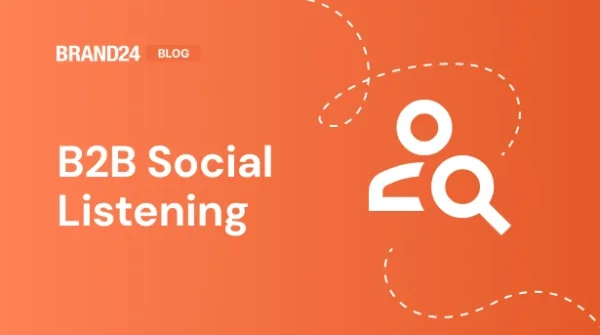What is AI Social Listening? Quick, Easy Guide for 2025
Table of contents
You may have heard the phrase social listening before, but what does it actually mean? At its core, it is the process of monitoring online conversations to understand what people are saying about your brand, products, services, and anything that may be relevant to your business. Wisely used, it will be a game changer in your marketing strategy.
According to the 2025 State of Social Listening report by Social Media Today:
- 89.4% of surveyed companies use social listening to analyze social data, making it the number one methodology for this purpose.
- Nearly 88% of agencies and over 68% of in-house brands perceive social listening and social data as important for achieving their business objectives.
- The primary social listening methods brands use are trend & mentions volume analysis, sentiment analysis, keyword & hashtag tracking, topic analysis, and AI-powered emotion classification.
Sounds interesting?
In this post, we’ll discuss everything you need to know about social listening.
So read on to learn more!
What is social listening?
Social listening is the process of tracking and analyzing online conversations to understand what people say about your brand, industry, or topics that matter to your business.
It combines monitoring mentions with sentiment analysis and trend detection to uncover insights that drive smarter marketing, stronger customer relationships, and strategic decision-making.
How does it work in practice?
Social listening works by using specialized tools to monitor specific keywords, brand mentions, hashtags, or topics on online platforms like social media, websites, forums, and blogs.
These tools gather conversations in real time, identify patterns – such as sentiment or recurring themes – and translate them into actionable insights.
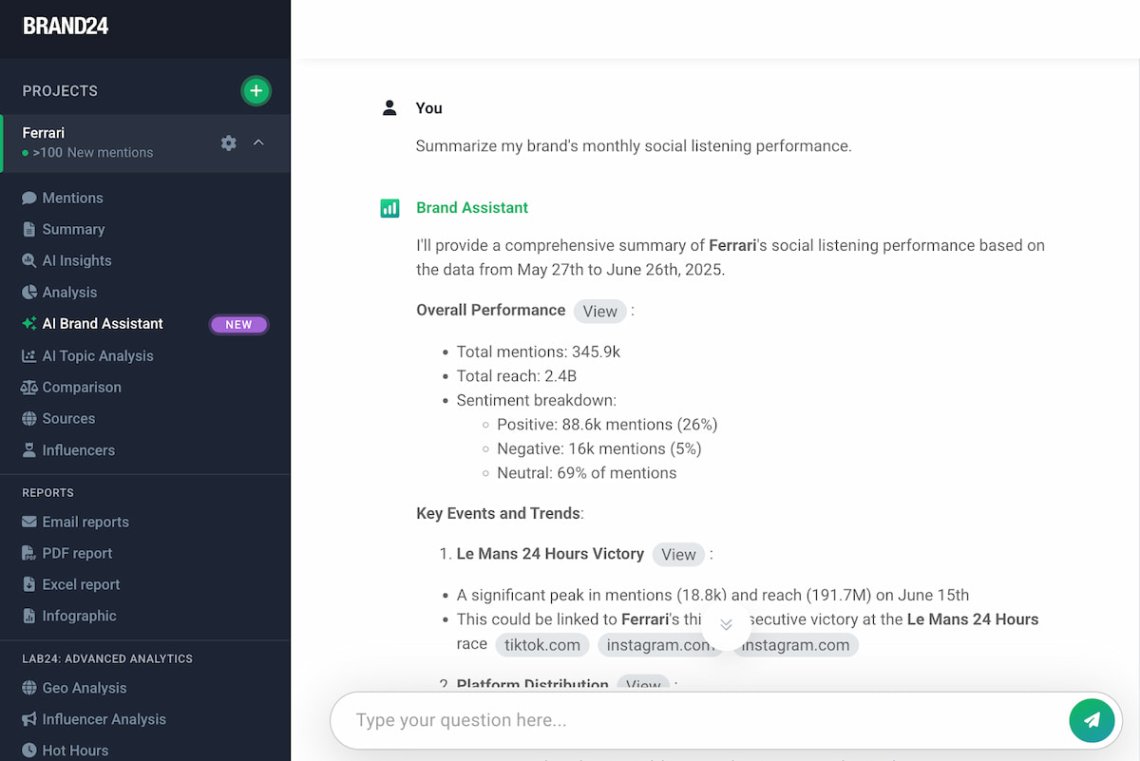
Start social listening right away!
Why is social listening important?
“Because online conversations are where today’s trust is built—and buying decisions are made. Especially in B2B, where purchases are costly and complex, people turn to their networks for real experiences, not Google.
Your audience is out there talking about their challenges, goals, and what’s changing in their industry. If you’re not listening, you’re missing a goldmine of insights to shape your messaging, content, and entire go-to-market strategy.”
Sara Stella Lattanzio, B2B marketing leader & LinkedIn influencer
Try Brand24 – the best social listening tool ever!
What is social listening in marketing?
Social listening in marketing is a strategic method for understanding your audience, the latest social media trends, and reacting to real-time sentiment signals.
By analyzing key conversations, comments, and reactions, you can discover inspirations for future campaigns and validate existing ones.
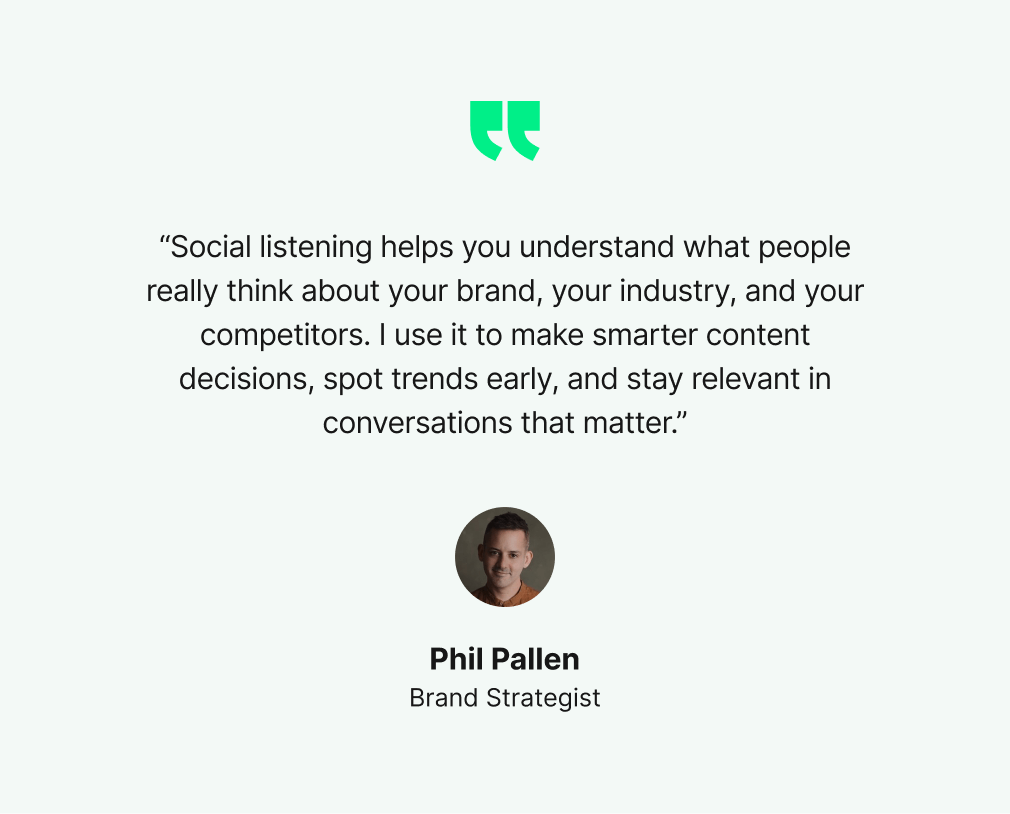
For example, in 2024, Apple released a promotional video that resulted in a huge increase in negative sentiment.
Thanks to social listening, Samsung quickly identified the rise of negative comments about its market rival and launched its own campaign as a follow-up to Apple’s video. And it became viral!
If you want to read the full story, check our article on the seven social listening examples from inspiring brands .
Social listening vs. Social monitoring
People frequently confuse social listening with social monitoring. It’s like confusing a thermometer with a doctor’s diagnosis (seriously!).
Because, whereas these concepts are close, they’re definitely not the same.
Social monitoring, also known as social media monitoring, tells you what people say about your brand on their social media posts and comments, how often they do it, and where they share it.
Your role is to track social media conversations and respond to them. Therefore, social monitoring is a reactive process. Or a part of something bigger.
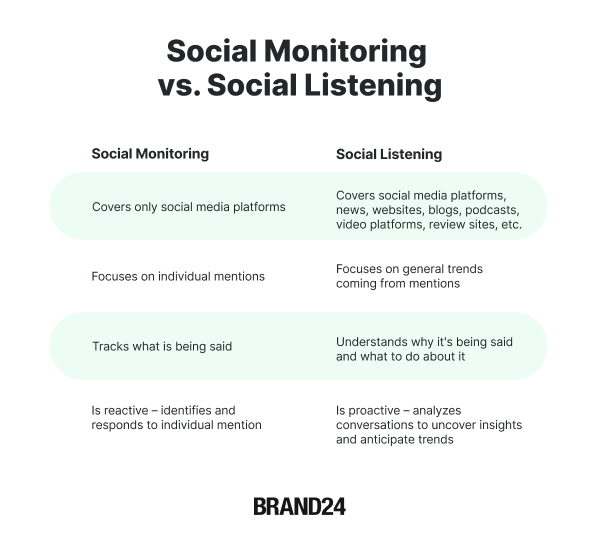
Social listening is the “something bigger”.
It digs deeper and aims to understand why people are saying what they’re saying, how they really feel about it, and what trends it reveals.
Here, you’re interpreting the collective voice, not only individual mentions.
You’re looking for patterns, sentiment trends, and frequent topics that can shape your brand strategy, content, customer experience, etc.
Summing up, social monitoring is a part of social listening – the part that observes and collects data, while social listening analyzes it to generate insights and guide strategic action.
Listen to & respond to your online conversations fast!
Key AI social listening methods & features
Artificial intelligence is no longer science fiction. It’s reality, and this reality applies to social listening efforts too.
Even more – AI is what makes modern social listening faster, smarter, and scalable.
Instead of manually sorting through thousands of mentions, AI tools do the heavy lifting for you – detecting patterns, interpreting emotions, and even suggesting what actions to take next.
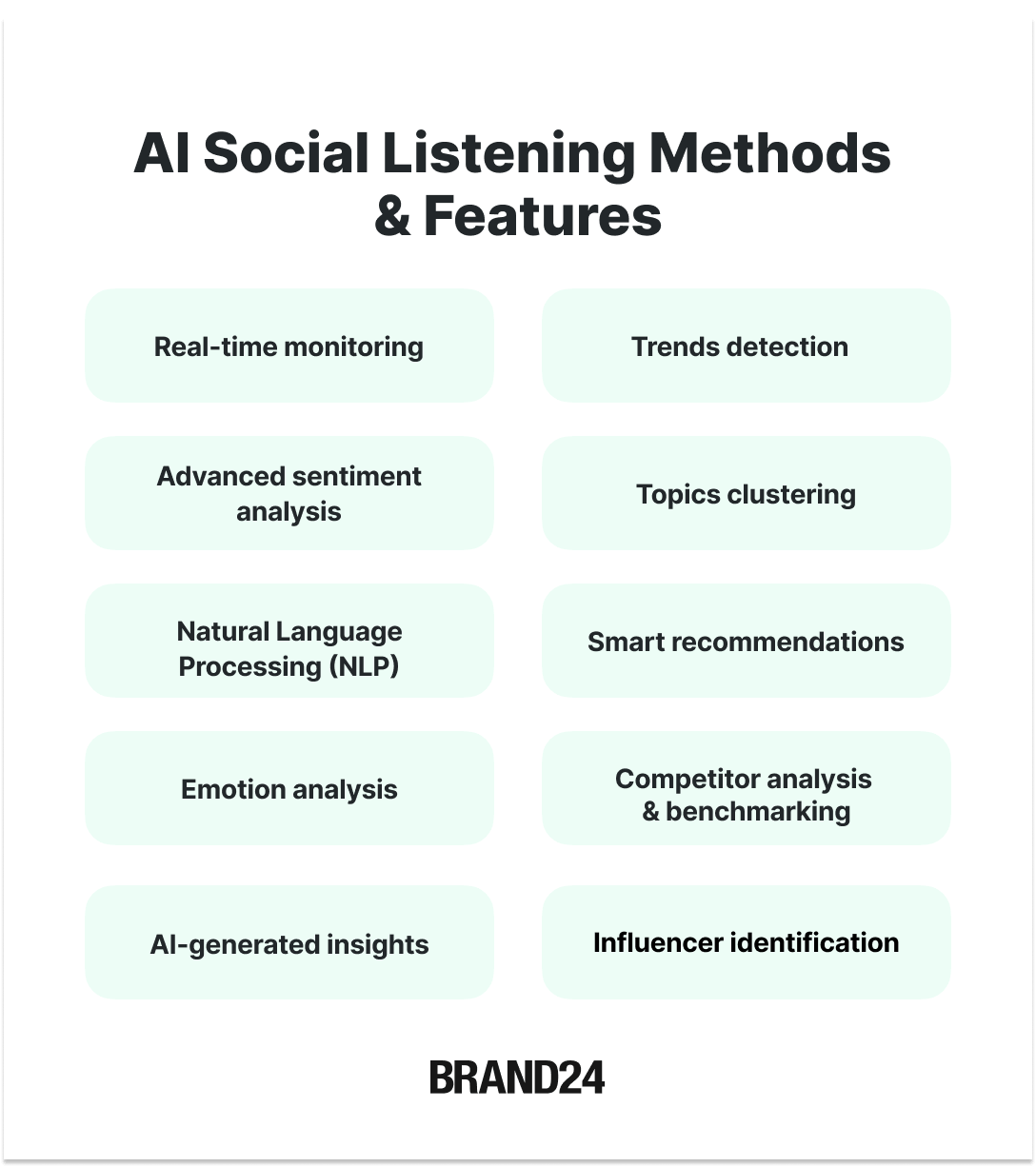
Here’s a short list of things that, combined with AI, turn basic monitoring into a powerful, insight-driven social listening strategy:
- Real-time monitoring
Being up-to-date by monitoring conversations as they happen. - Advanced sentiment analysis
Understanding whether people are talking about your brand in a positive, negative, or neutral way. - Natural Language Processing (NLP)
The tool goes beyond keywords to discover the true meaning and context of what people are saying. - Emotion analysis
Detecting detailed emotions such as joy, sadness, anger, or fear to deepen your audience’s understanding. - AI-generated insights
Automated summaries and key findings from your raw data. - Trends detection
Spotting emerging trends in conversations before they become mainstream. - Topics clustering
The AI algorithm identifies and organizes relevant topics for discovering patterns. - Smart recommendations
Real-life & data-backed suggestions to improve communication, messaging, and engagement. - Competitive benchmarking & analysis
Comparing your brand performance and sentiment to your industry rivals. - Influencer identification
Discovering the voices that matter most in your niche and building authentic partnerships.
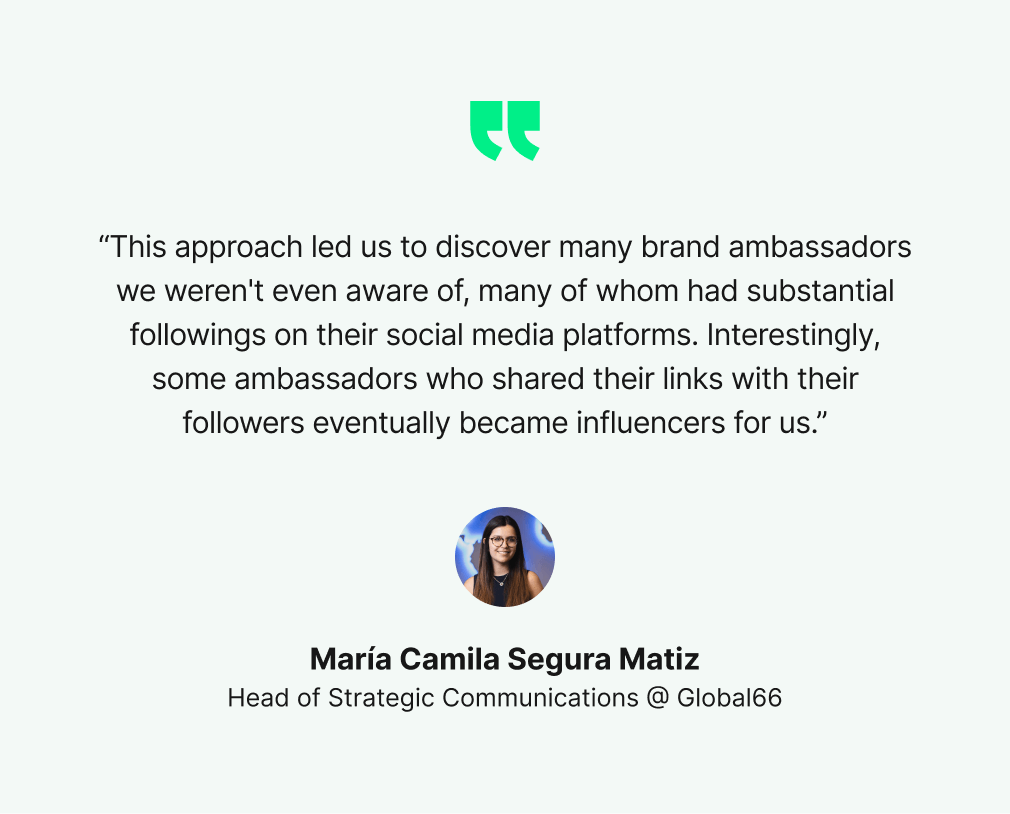
Try the AI-powered social listening!
What are the benefits of social listening?
We must clarify one thing: social listening isn’t just about tracking mentions – it’s about unlocking real business value.
As such, it becomes a powerful asset in any brand’s toolkit.
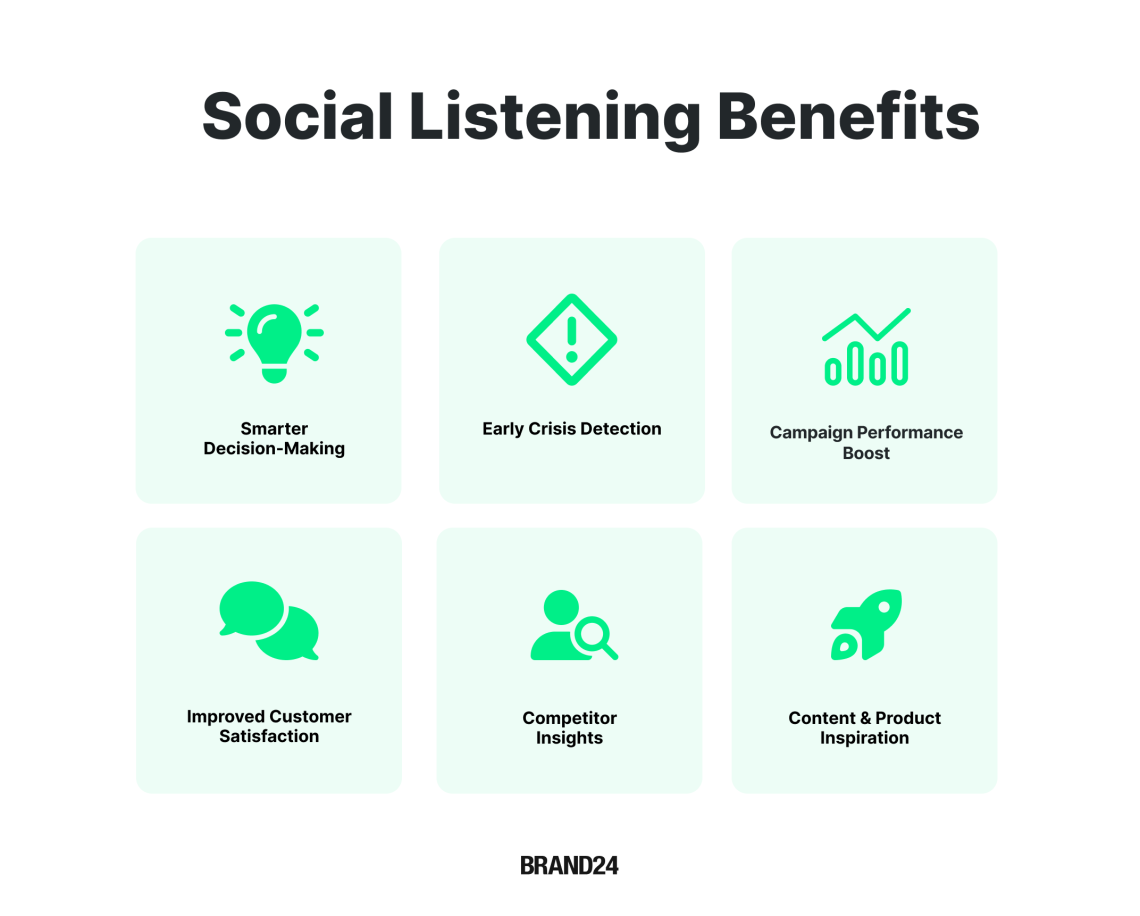
Here are the key benefits that make it an essential part of all brand and marketing strategies:
- Smarter decision-making
Analyzing audience sentiment, identifying trends, and discovering customer feedback allows you to make data-informed decisions across marketing efforts, product development, and customer service.
As Semrush’s Social Media Trends Report states, social media listening helps to identify emerging trends even 3 times faster and thus, capitalize on new opportunities before market rivals.
- Competitor insights
The 2025 State of Social Listening report cited above clearly shows that competitor analysis is the primary use case for analyzing social data, both for agencies and independent brands.
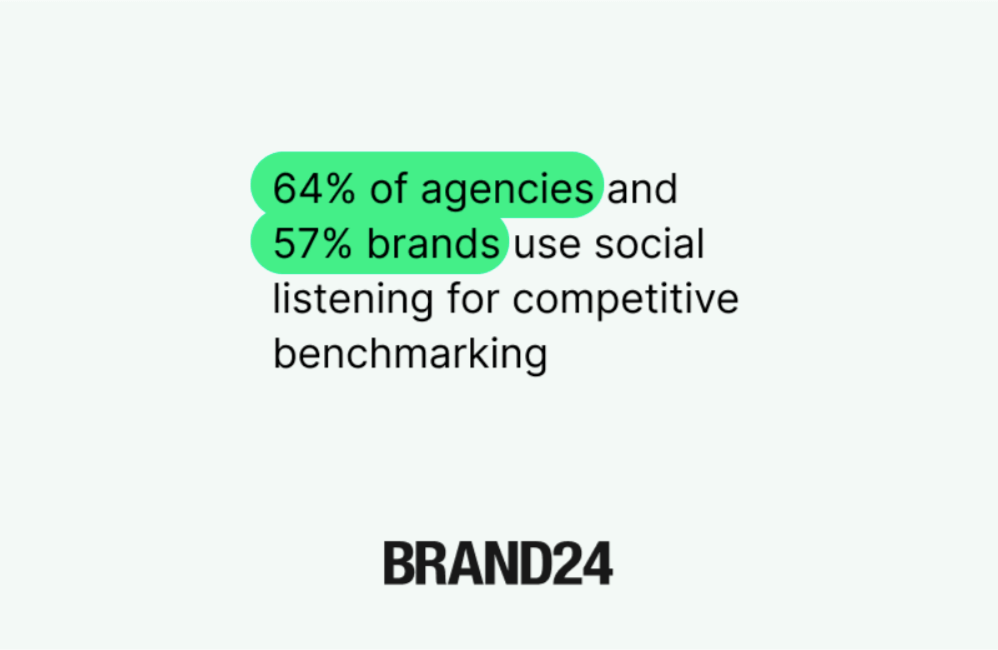
So, use social listening to monitor what’s being said about your competitors. Learn from their wins and mistakes to improve your own positioning and strategy.
- Early crisis detection
Brand reputation crisis is considered one of the top 8 global business risks (AON report).
The good news is that social listening tools are made to detect early warning signs, monitor public sentiment, and help you respond before a crisis escalates.
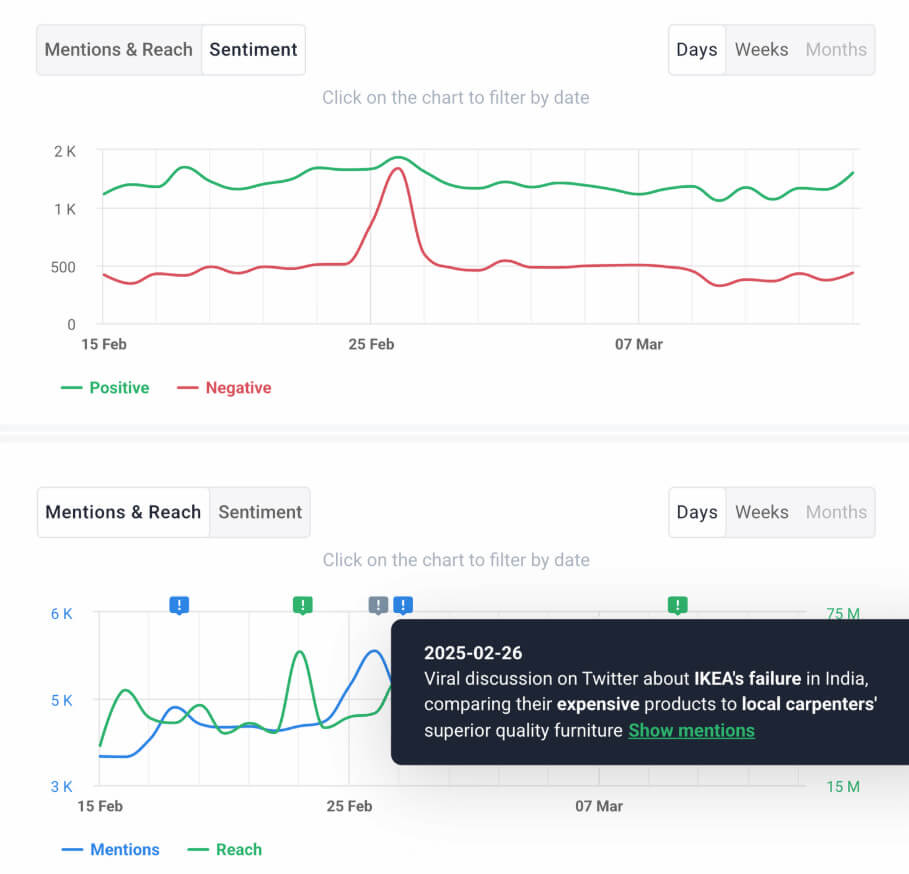
With real-time alerts and emotion analysis, social listening tools equip brands to stay ahead, protect their reputation, and act fast when things start to go wrong.
- Campaign performance boost
Social listening works perfectly for evaluating the performance of your content and social media marketing campaigns.
According to Socialbakers, social listening can improve campaign return-on-investment by even 25%! How? By more accurate targeting and content creation.
- Improved customer satisfaction
Listening to customer conversations lets you understand their emotions & preferences, detect frequently reported issues and – ultimately – improve customer feedback. Evidence?
According to the McKinsey report, companies implementing social listening into their customer experience strategy enjoy a 17% higher customer satisfaction rate than competitors.
- Content & product inspiration
Social listening uncovers the questions, frustrations, and interests your audience talks about organically. That’s pure gold for content ideas and product development.
Enjoy the power of AI social listening & grow your business!
How to use social listening? 6-step strategy
Social listening is a quite simple process, but you’ll need the right brand monitoring tool.
Of course, you can do it manually, but it’s much more time-consuming and less effective.
Here are 6 steps that will help you set up your social listening strategy.
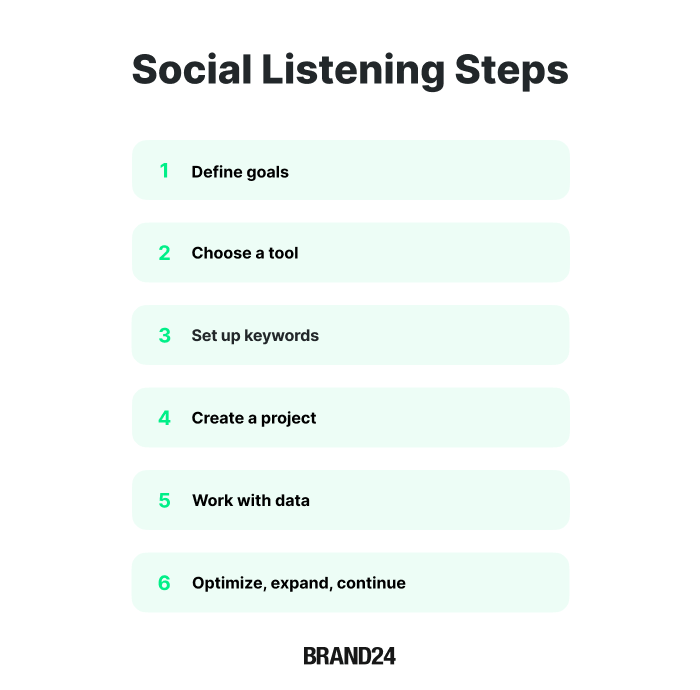
Step 1: Define your goals
In the beginning, decide what you want to achieve with social listening.
Seriously, many people ignore this initial step and follow the “it will work out somehow” strategy. Wrong way.
Without clear goals, you’re just collecting data with no direction. It’s like driving a car just for fun – you can enjoy it, but you’re wasting your brand resources for nothing truly meaningful.
Instead, define what goal (or goals) will guide your social listening strategy.
And you have plenty to choose from:
- Brand reputation management
- Increasing brand recognition
- Social media analytics
- Improving customer experience & service
- Building customer engagement
- Getting customer feedback
- Tracking campaign performance
- Identifying brand ambassadors & candidates for influencer marketing
- Content creation and distribution
- Brand health tracking
In practice, according to the State of Social Listening 2025, the most frequent social listening goals for real businesses are:
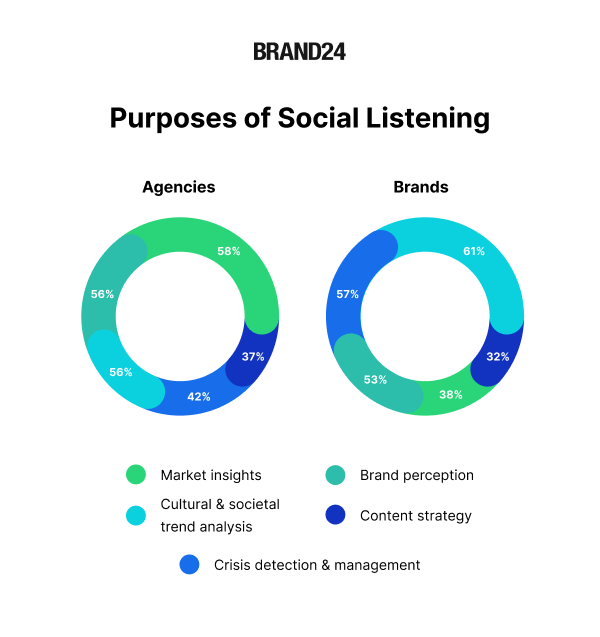
- Market insights (58% of agencies and 37,5% of brands)
- Brand perception (56% of agencies and 52,8% of brands)
- Cultural & societal trend analysis (56% of agencies and 61,1% of brands)
- Crisis management (42% of agencies and 56,9% of brands)
- Content strategy (37% of agencies and 31,9% of brands)
Remember, though, that choosing your goal or goals for your social listening strategy is not a lifetime decision! They can evolve with time.
What’s important is to have a well-defined starting point.
Try the best AI social listening tool!
Step 2: Pick a social listening tool
Theoretically, you can do social listening manually and research social media channels to identify valuable mentions. But is it effective? Definitely not.
It takes a lot of time, and there is a high chance you will miss important posts.
Advanced social listening tools research data sources automatically and help you identify the most popular and important mentions, draw valuable insights, and identify emerging trends
So, once you have your goals in place, it is time to pick the right tool that will do most of the job for you. Usually, you can sign up for a trial to test a tool before you buy it.
Try Brand24 for free!
When looking for the right tool, check those 5 factors:
- Number of monitored sources – the more, the better
- Features that will support your goals – pay attention if the tool constantly develops its features, and if it includes helpful AI social listening features
- Cost-effective pricing – depending on your budget and scale
- Opinions posted on tools review websites – I recommend checking G2 and Capterra
- Customer support – issues happen frequently, so choosing a tool with a great customer service team is important.
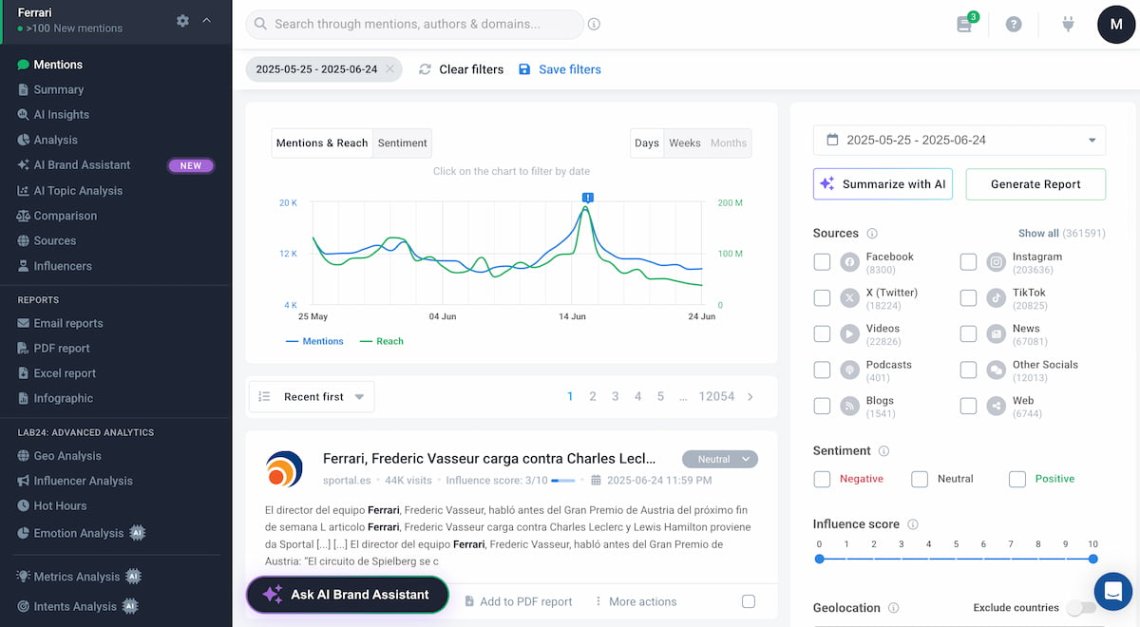
Check: The Best Social Listening Tools
Step 3: Set up the keywords you want to track
Social media listening tools do their job thanks to tracking keywords. Such a keyword can contain anything: a brand name, a hashtag, an industry-relevant topic, and any other phrase.
Now, your task is to define what you want to monitor. Pick the keywords that match your goals.
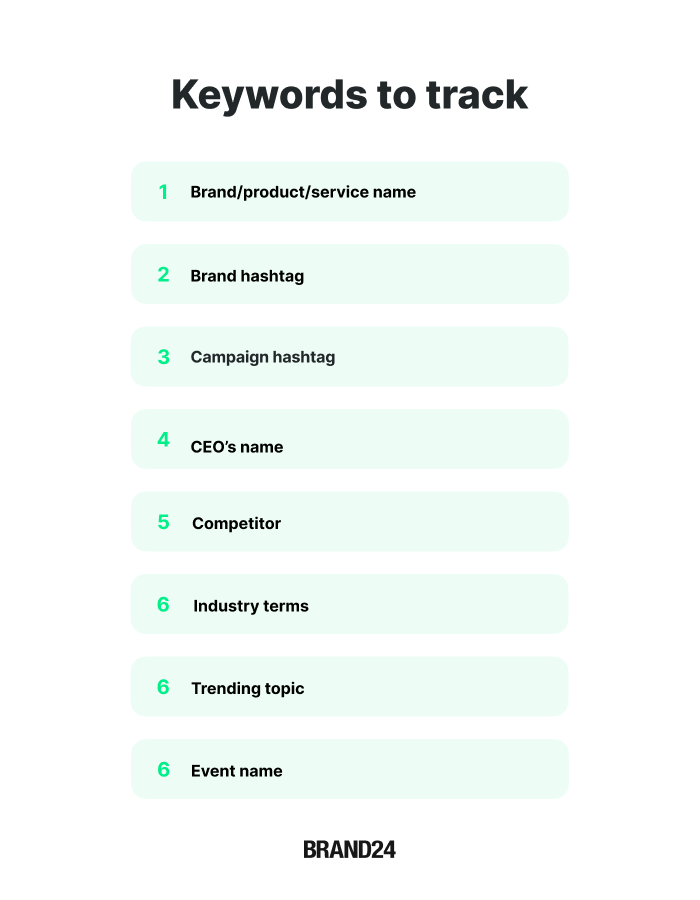
Think about what will work best, like:
- The name of your brand, product, or service
- Your company hashtag
- Your campaign-specific hashtag
- Your CEO’s or any other prominent employee’s name
- Your competitors’ brand names and hashtags
- Industry buzzwords
- Trending topics relevant to your niche
- Names of events you’re participating in or sponsoring
Start your social listening like a pro!
Step 4: Create a monitoring project
Setting up a monitoring project is relatively easy. Most social listening tools have a similar process, so I’ll discuss the process using Brand24.
Below, you can see the project creation wizard. To run a project, you need to set up the main keyword, hashtag, or phrase for which your project will collect data.
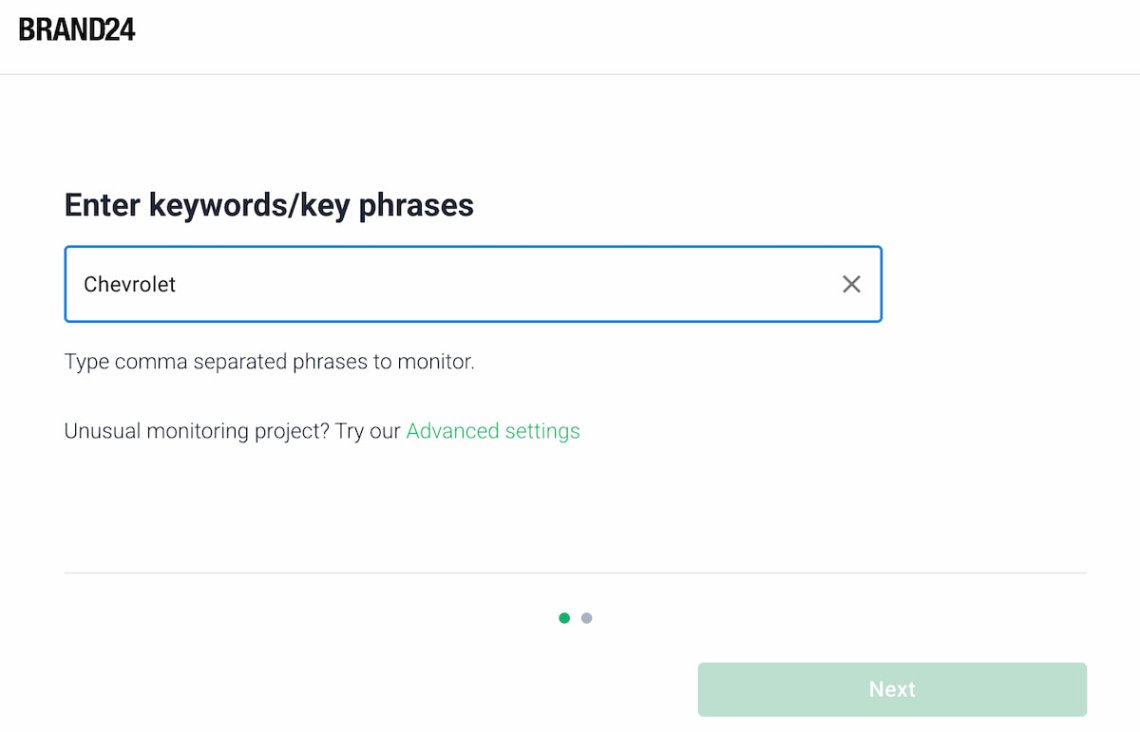
Then, you can add optional advanced settings, such as:
- Project name
- Required keywords – each of which must appear in order for the mention to be collected
- Excluded keywords – each one of which can appear if the mention is to be collected
- Language(s) – include or exclude specific languages
- Sources – include or exclude specific data sources
- Notifications – rules for receiving mobile or email notifications
- Reports – daily & weekly reports, as well as Storm Alerts rules (for sudden spikes in mentions that may indicate a crisis or viral trend).
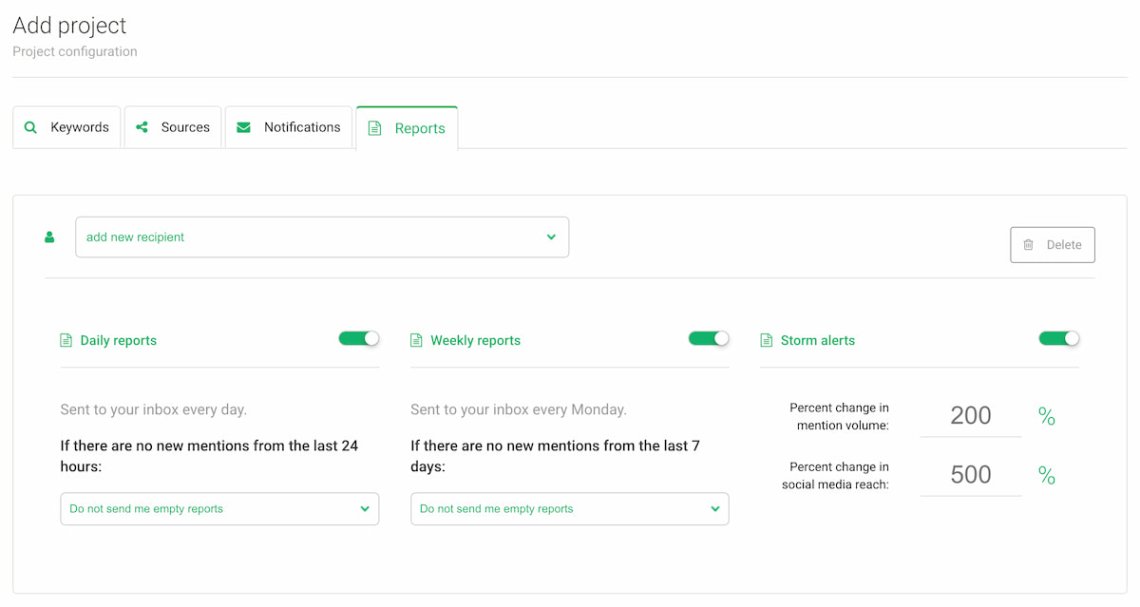
Set up your social listening project in seconds!
Step 5: Work with social listening data
Okay, you’re all set up! Now, it’s time to explore social listening data.
In the Mentions tab, you’ll start seeing results whenever someone mentions your keywords on social & non-social platforms.
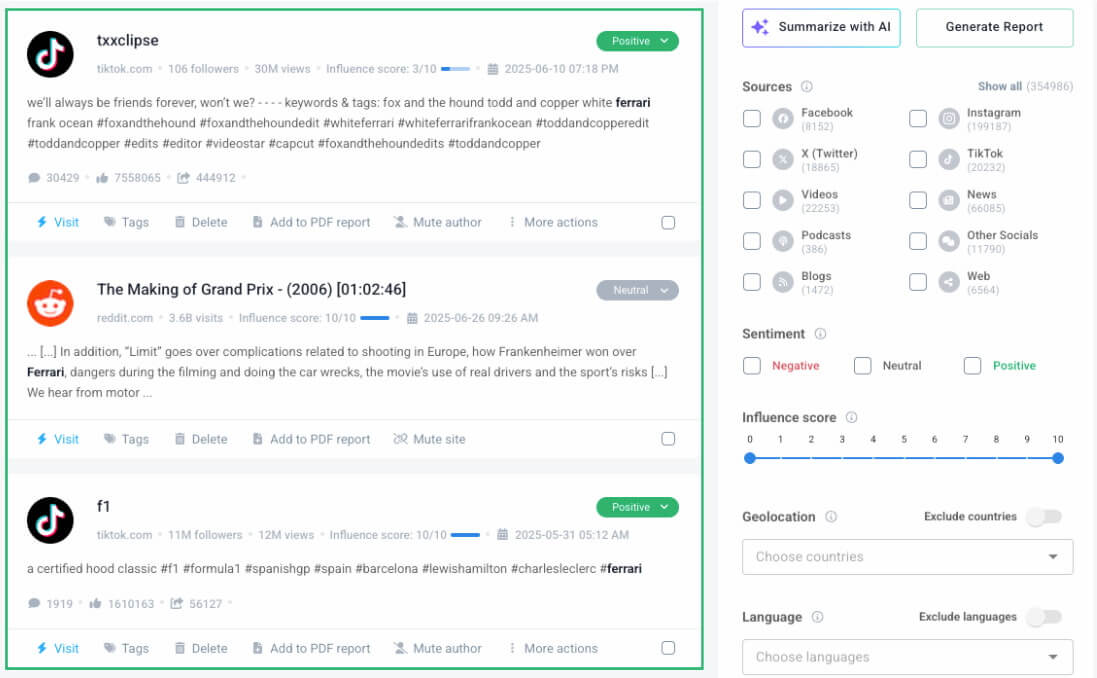
From there, you can engage with them directly or take action based on what you “hear”. The good practice is to monitor the results regularly and respond as necessary.
Try the AI-powered social listening!
Now you can:
- Click on mentions to be redirected to the social media platform, where you can directly respond.
- Discover sources (platforms) that deliver the most mentions, so you will be able to pick social media platforms that are the most effective.
- Sort results by popularity to discover the most influential & important mentions and treat them as a priority.
- Check the sentiment of each mention so you can respond to negative ones quickly.
That’s just the tip of the iceberg. There are many more benefits and use cases. You will find them in the next step.
To gain comprehensive knowledge on how to do social listening, check the webinar hosted by Monika, Customer Success Manager at Brand24.
You will learn how to:
✔️ Create a project
✔️ Interpret social listening data
✔️ Take advantage of Brand24’s features to benefit your business.
Check the video 👇
How can brands use social media listening to identify and engage with their target audience?
“Social media listening gives you all the information you need about the right channels, topics, people, and hashtags to connect with your audience. All you need to do is use this data and go out there!”
Justyna Dzikowska, Head of Marketing at Brand24
Start your social listening right away!
Step 6: Optimize, expand, and continue
At this stage, you have probably tested your social listening strategies. It’s time to maximize your results and reach even further.
How to do it?
Take a look at the tips written by Adam Górnicz, Customer Success Manager at Brand24, who is an expert in optimizing social listening projects.
Optimize
Using the brand’s X (Twitter) handle, domain, or Facebook URL as additional keywords may boost your results significantly.
Remember, some posts may contain one of those forms, instead of the full brand’s name, and you gotta catch ’em all, right?
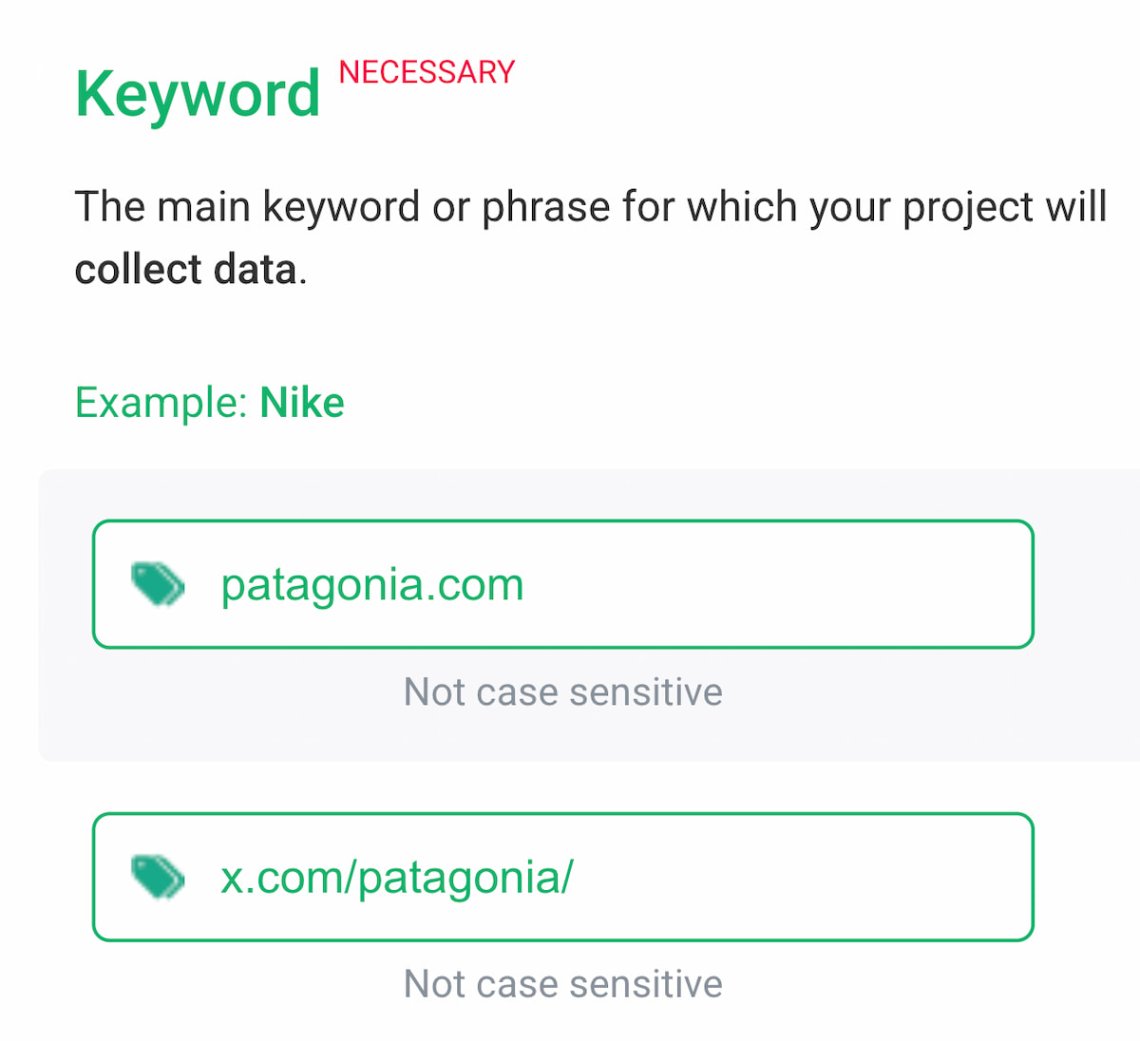
Try AI-powered social listening!
Polish
One of the few things that may improve your results in terms of their relevance is the skillful use of the excluded keywords section.
With the help of this function, mentions containing excluded keywords will not appear in your data pool ever again.
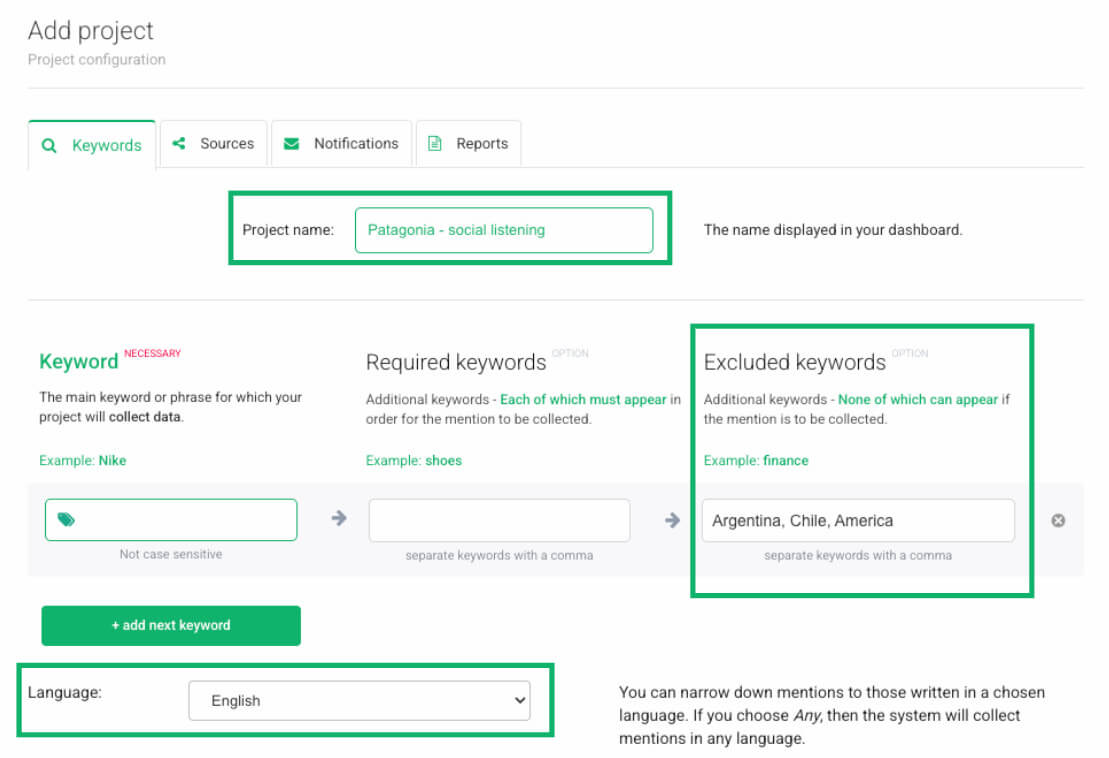
But hey, you don’t have to meditate trying to figure out what are the words that appear with your mentions the most, to choose the irrelevant ones.
The context of a discussion tab, in the Analysis tab, will do it for you:
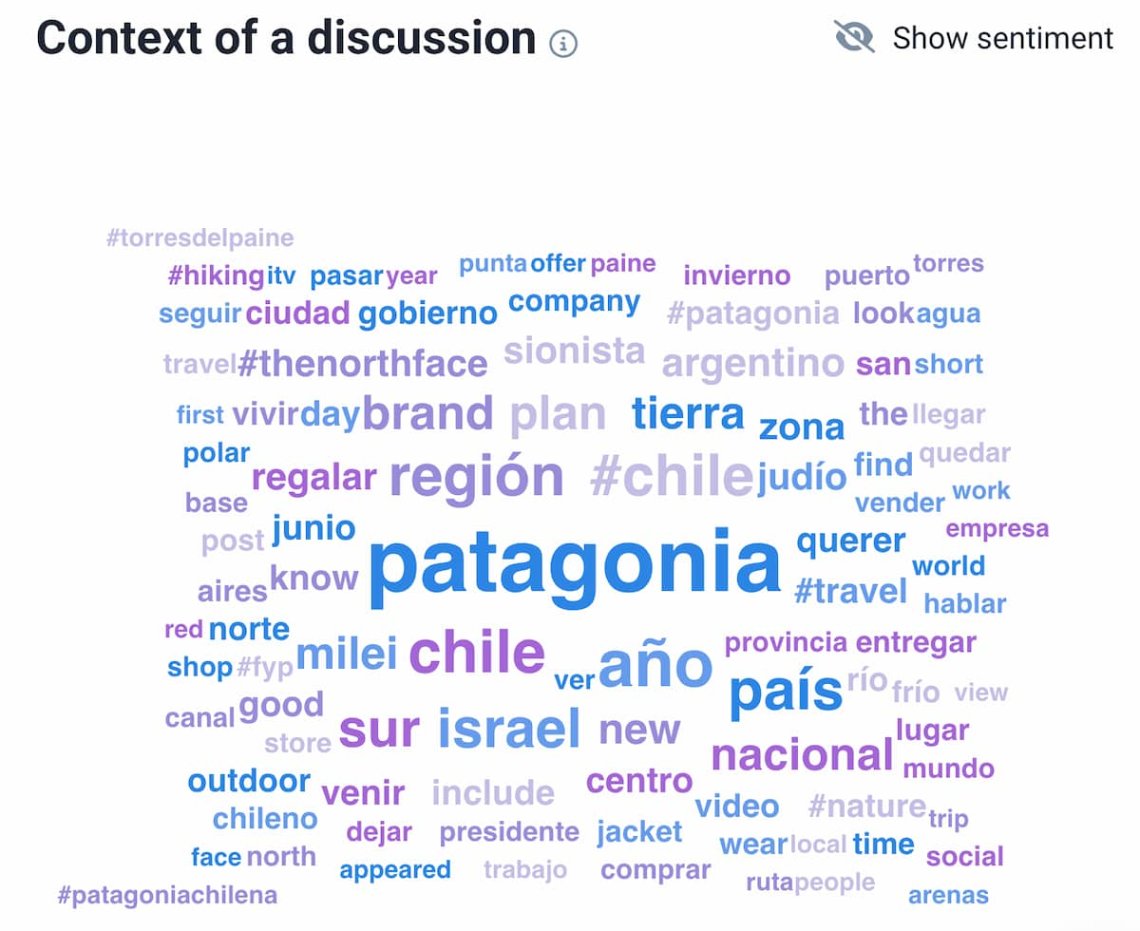
Extend your point of view
Instead of monitoring the brand or the competitors only, try to look at the bigger picture.
Keeping your social listening eye on the industry itself may be very beneficial.
It can translate into more potential clients, valuable information about industry trends, or data you wouldn’t even expect to find!
Understand how others talk about your brand!
But how exactly are you supposed to do that?
- Create a project with the topic and its variations as keywords, choosing the language you are interested in.
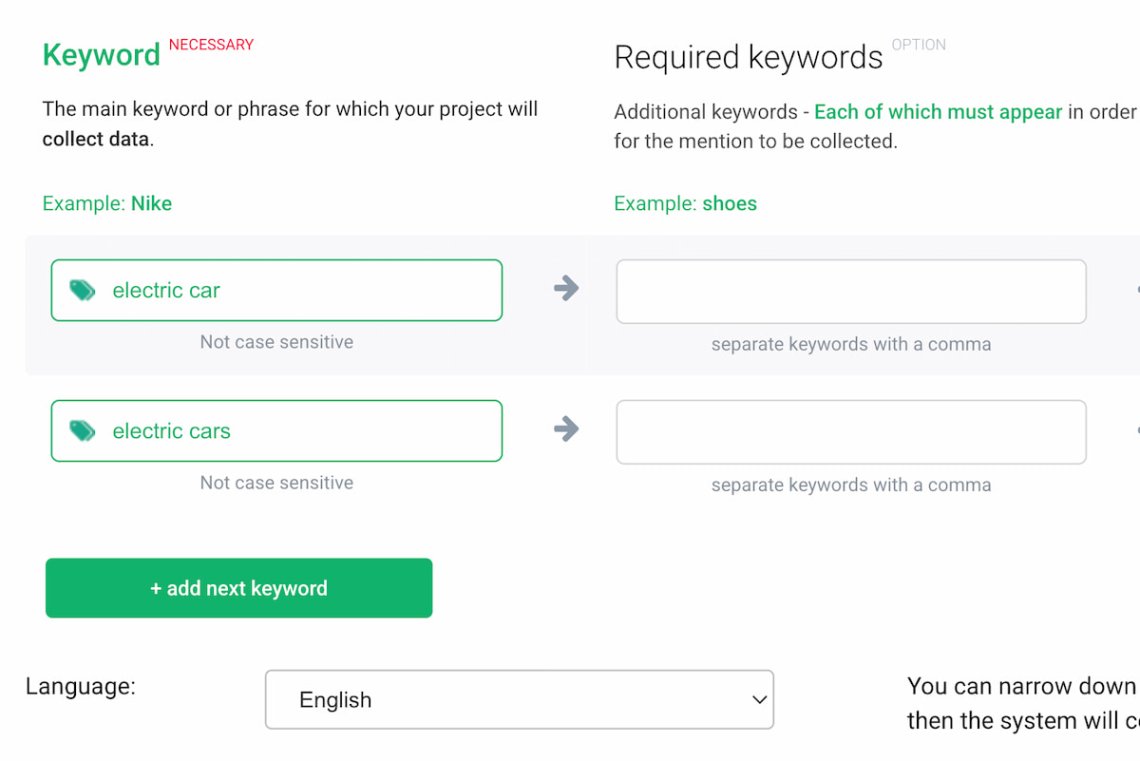
- Analyze our good ol’ context of a discussion tab (man, I really love that feature!).
Even at first glance, it gives you an overall view and shows the brightest points, like the biggest problems, the biggest players, or even clues to hot discussions around the subject.
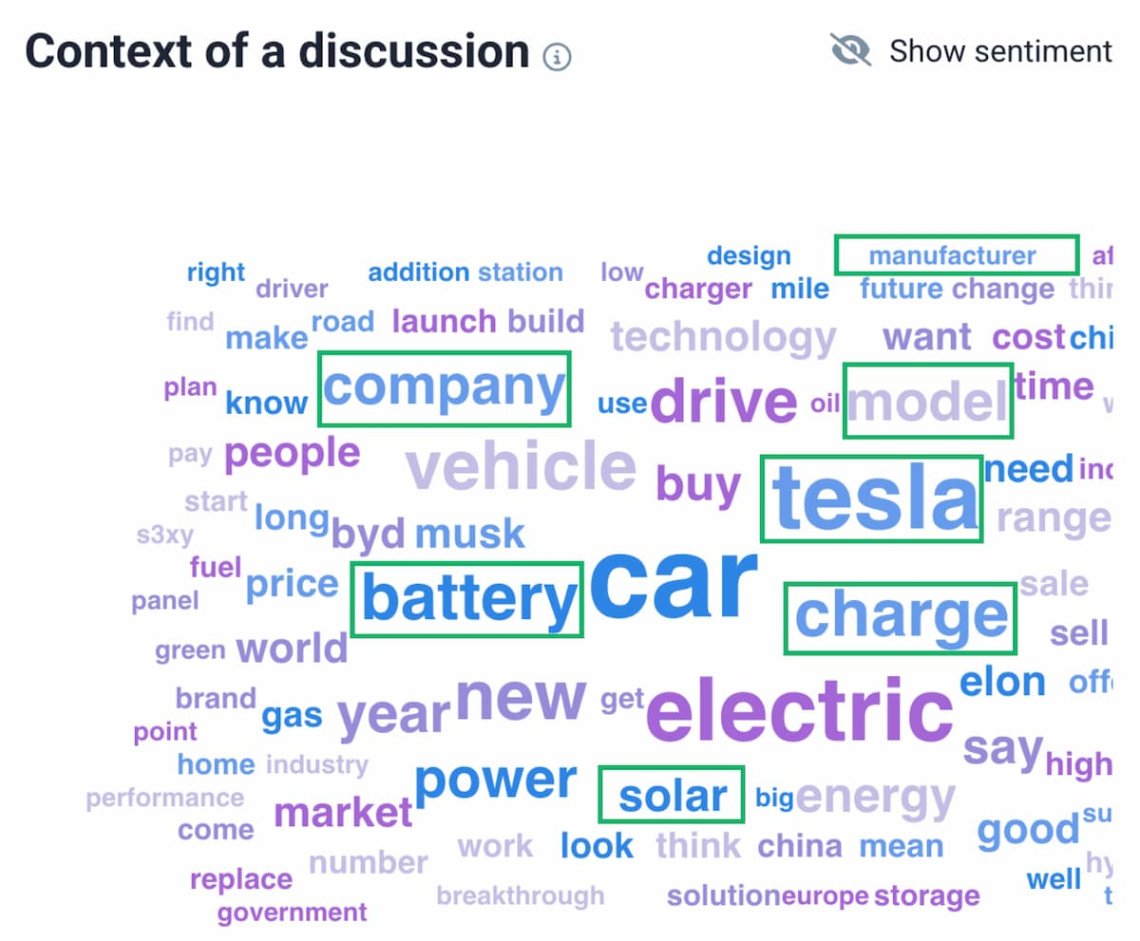
- Learn about the most influential social media profiles in the industry, with the help of the Most Share of Voice and Most Followers profiles tab, and track their posts and opinions.
After all, it is their opinion that often influences setting trends.
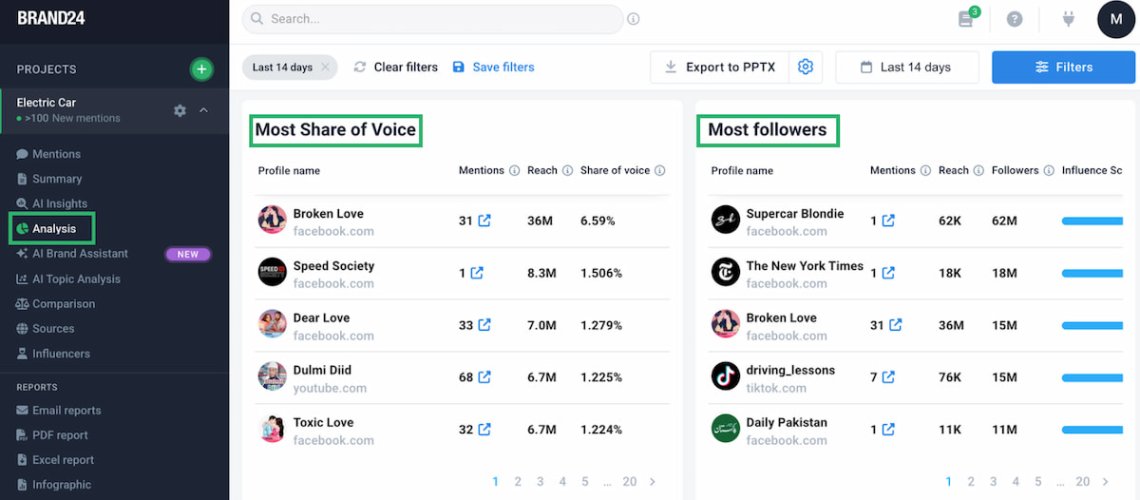
- Keep tracking the most popular mentions manually.
The more popular the post, the bigger its impact on the industry may be, so keep up with the most popular ones at least.
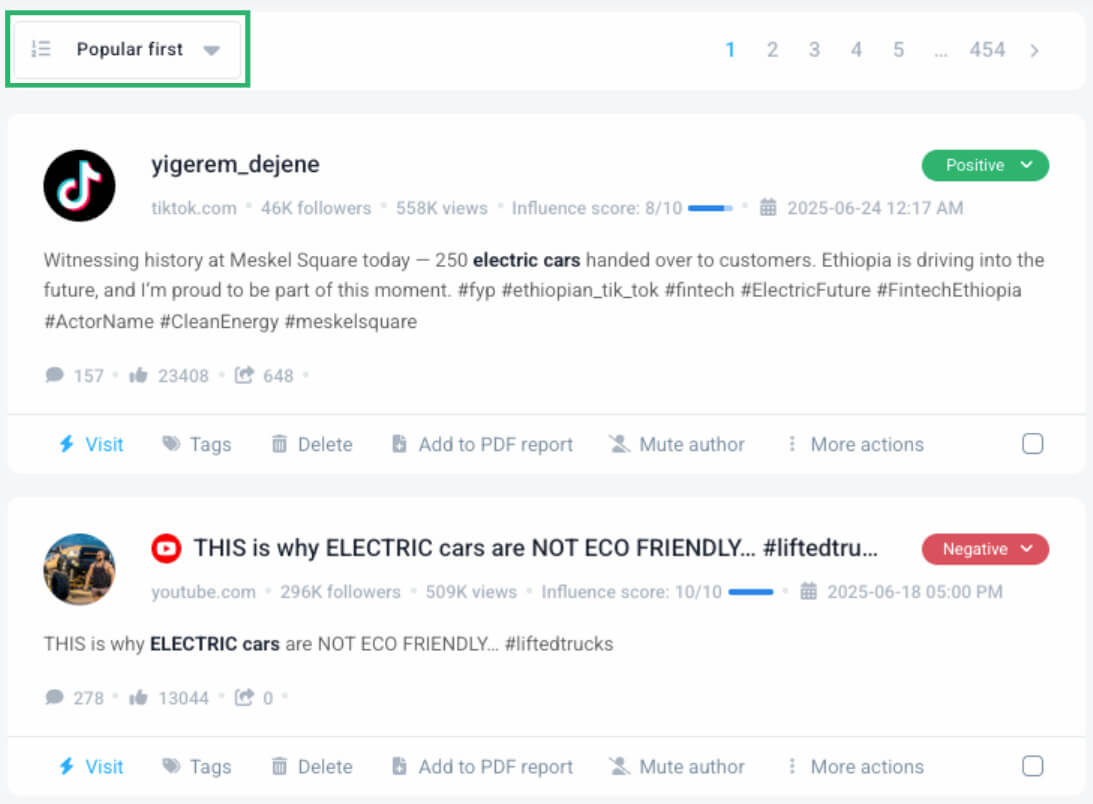
Using the social listening tips above will surely improve your results and make you feel like a media monitoring ninja!
Try Brand24 – the best social listening tool in the Universe!
Social listening case study: Uber’s 24% online exposure increase
In 2016, Uber launched a redesigned rider app to boost its user experience. The brand needed a way to understand public reception at scale.
By leveraging social listening with Brand24, Uber implemented the following approach:
- Monitored baseline brand mentions before the app release.
- Tracked real-time sentiment to check the audience’s reactions.
- Analyzed spikes in engagement (likes, shares, and comments).
- Collected user-generated feedback to guide future app development.
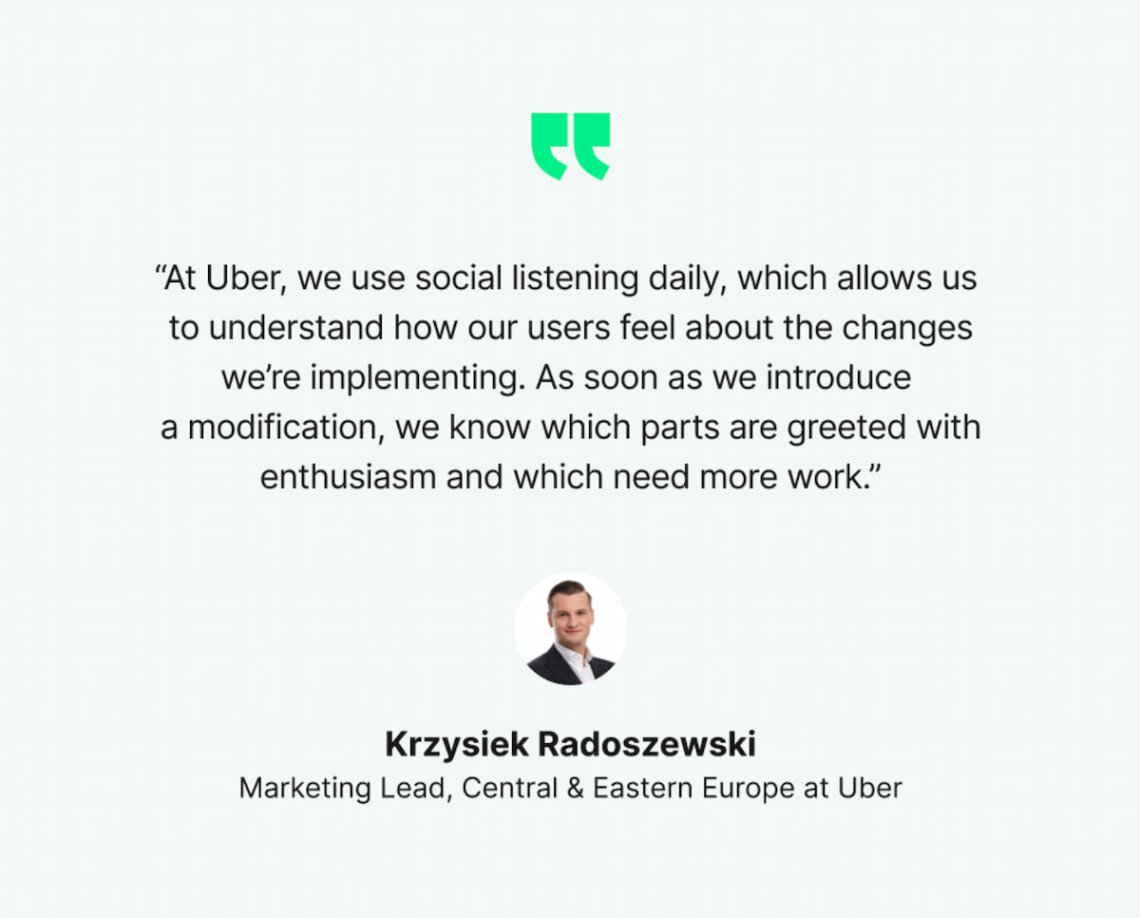
As a result, Uber achieved:
- 100% increase in online mentions within 48 hours
- 250% more shares and 90% more likes compared to pre-launch engagement
- 24% boost in online exposure during a 1-day campaign (Uber Ice Cream)
- 11% growth in new users and 7% increase in rides per user
Further read: the full Uber case study
Key takeaway: Real-time social listening helped Uber to measure product reception instantly, upgrade the app experience, and turn insights into measurable business results.
Try social listening and boost your business growth!
Conclusion
We’ve covered a lot today, so let’s review!
Social listening is the process of understanding online discussions, gaining insights, and taking accurate actions to improve your business.
It helps you to identify the crucial online mentions and turn them into real opportunities for growth.
By tracking relevant conversations on social & non-social media platforms in real time, you can learn what your audience actually thinks, feels, and expects.
AI-powered social listening tools make it easier to analyze sentiment, detect trends, and uncover patterns at scale.
This allows brands to react quickly, adjust campaigns, and shape their messaging based on real data, not guessing or estimations.
Final thoughts:
- Manual social media listening is time-consuming and less effective. Instead, use AI-powered social listening tools that will automate the process and do most of the job for you.
- The main reasons why companies invest in social listening are doing market research, measuring brand perception, analyzing trends, crisis detection & management, and improving content strategy.
- Social listening can help you find leads, but you must set up a project correctly and use filters smartly.
- Starting social listening is simple, but you need to pick your goals and choose relevant keywords you want to monitor first.
- Most of the tools, like Brand24, offer a free trial so you can test them carefully.
Start a 14-day free trial and test the Brand24 tool and do your social listening like a pro!
Related articles

![How to Create a Social Listening Report? Template & Example [2025]](https://brand24.com/blog/app/uploads/2025/06/social_listening_report_blog_cover_615x345-600x335.webp)

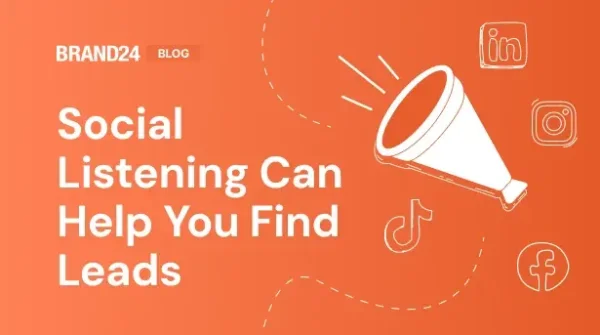

![How to Track Social Mentions? [2025 Guide]](https://brand24.com/blog/app/uploads/2023/11/how_to_track_social_media@2x-1-600x335.webp)
